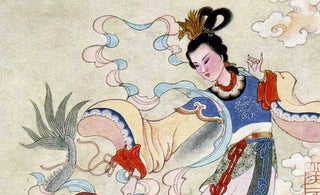
1. Introduction: Embracing the Divine Feminine in Tibetan Tradition
In the tapestry of Tibetan rituals and ceremonies, the veneration of goddesses plays a pivotal role, weaving threads of spirituality, devotion, and cultural richness. Among the myriad divine figures, the Eleven-faced Goddess of Mercy with Thousand Hands and Thousand Eyes stands as an embodiment of compassion and profound spiritual significance. This celestial being, often depicted in Tibetan Buddha Jade Yellow Porcelain Oriental Classic Crafts, encapsulates the essence of the divine feminine in a mesmerizing and intricate form.
Tibetan culture encapsulates a rich tapestry of spiritual beliefs and practices, including a profound reverence for the divine feminine. In this exploration, we delve into the multifaceted realm of Tibetan goddesses, embodiments of compassion, wisdom, and transformative power. These celestial figures stand as pillars of strength and inspiration, weaving through the intricate fabric of Tibetan spirituality.
2. Archetypes of Tibetan Goddesses: A Pantheon of Grace and Power
Tibetan mythology boasts a diverse pantheon of goddesses, each embodying unique attributes and roles. Among these luminous beings, figures like Tara, the compassionate and swift to act; Saraswati, the epitome of wisdom and creativity; and Kurukulla, symbolizing enchantment and magnetism, stand out. These goddesses personify various virtues, offering guidance and blessings to devotees seeking their divine grace.
3. Rituals and Devotion: Honoring the Divine Feminine in Tibetan Practices
Tibetan rituals and ceremonies often center around venerating goddesses. Devotees engage in elaborate rituals, prayers, and offerings to invoke the blessings of these celestial beings. Festivals like the Saga Dawa and Losar witness vibrant celebrations where homage is paid to the divine feminine through sacred dances, chants, and offerings. These rituals serve as a testament to the enduring reverence for the feminine energy in Tibetan society.
The Eleven-faced Goddess of Mercy, known as Ekadashamukha Avalokiteshvara in Sanskrit, holds a paramount place in Tibetan Buddhism. This bodhisattva, an enlightened being dedicated to helping all sentient beings attain enlightenment, is revered for her ability to manifest a multitude of compassionate actions simultaneously. The depiction of Eleven faces, each adorned with gentle expressions, signifies the omnipresence of compassion, transcending spatial and temporal boundaries.
In Tibetan Buddha Jade Yellow Porcelain Oriental Classic Crafts, the craftsmanship dedicated to portraying this goddess reflects a profound commitment to capturing both aesthetic beauty and spiritual depth. The use of jade yellow porcelain, with its rich symbolism of purity and enlightenment, adds layers of meaning to the artistic representation. The intricate details of the porcelain craft, from the delicate rendering of each hand to the thousand eyes symbolizing omniscient awareness, contribute to a visual narrative that transcends the physical form.
The ritualistic engagement with this goddess often involves intricate ceremonies where devotees come together to honor her benevolence. The Saga Dawa and Losar festivals serve as poignant examples of these celebrations. During these vibrant occasions, the air is filled with the melodious cadence of sacred chants, the rhythmic dance of devoted practitioners, and the sweet aroma of incense wafting through the sacred spaces. Elaborate rituals unfold, weaving a tapestry of devotion as offerings are made to invoke the blessings of the Eleven-faced Goddess of Mercy.
Sacred dances, known as Cham dances, are a hallmark of these festivals. The dancers, adorned in vibrant costumes and intricate masks, enact spiritual narratives that often include the compassionate deeds of the goddess. Through these dances, devotees not only pay homage but also seek to embody the virtues and qualities symbolized by the divine feminine. The dance becomes a spiritual journey, a communion with the goddess's essence, and a way to invoke her compassionate presence.
The chanting of mantras dedicated to the Eleven-faced Goddess of Mercy reverberates through these ceremonies, creating a sacred ambiance that transcends the material realm. Devotees recite prayers with heartfelt sincerity, seeking the goddess's blessings for compassion, healing, and spiritual awakening. The act of offering, whether it be symbolic gestures or tangible gifts, becomes a means of expressing gratitude and devotion to the divine feminine.
4. Symbolism and Iconography: Unveiling the Mysteries of Tibetan Goddesses
The iconography surrounding Tibetan goddesses is laden with symbolism, conveying profound messages and teachings. Each goddess is depicted with specific attributes, gestures, and objects carrying symbolic significance. For instance, the multiple arms of Tara symbolize her ability to extend help in various directions, while the serene visage of White Tara exudes compassion and purity. Understanding these symbols unravels layers of spiritual wisdom embedded in Tibetan art and culture.
5. Empowerment and Contemporary Significance: The Relevance of Tibetan Goddesses Today
Beyond their historical and mythological significance, Tibetan goddesses continue to resonate in the contemporary world. Their enduring presence serves as a source of empowerment, inspiring individuals globally to embody compassion, wisdom, and resilience. Moreover, the elevation of the divine feminine in Tibetan culture speaks to the ongoing global pursuit of gender equality, fostering a deeper appreciation for the strength and grace inherent in the feminine aspect.
The Jade Yellow Porcelain Oriental Classic Crafts, serving as vessels of artistic expression, become conduits for the sacred energy embodied by the goddess. The crafts themselves become objects of veneration, representing the convergence of artistic mastery and spiritual significance. The subtle hues of jade yellow symbolize the purity of heart and mind, aligning with the transformative journey towards enlightenment that the goddess embodies.
Conclusively, the exploration of Tibetan goddesses illuminates a path that intertwines spirituality, culture, and empowerment. These divine figures stand as embodiments of timeless virtues, offering guidance, solace, and inspiration in both ancient traditions and the modern world. The essence of the divine feminine, as portrayed through these goddesses, transcends boundaries, inviting all to embrace compassion, wisdom, and the transformative power inherent within.
























